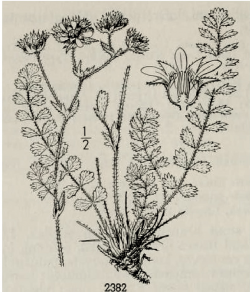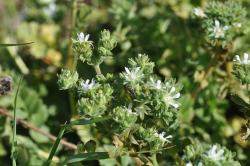
endangered

Illustration from Abrams (1944).

© 2014 Michael Chassé.



This fact sheet was prepared by Dylan M. Neubauer under award NA04N0S4200074 from the National Oceanic and Atmospheric Administration (NOAA), U.S. Department of Commerce (DOC). The statements, findings, conclusions, and recommendations are those of the authors and do not necessarily reflect the views of the NOAA or the DOC.
© Copyright 2006, Elkhorn Slough Coastal Training Program
Last updated: Jun 2, 2015 16:13
Common Names - Kellogg's horkelia, wedgeleaf horkelia
Family - Rosaceae (Rose Family)
State Status - none
Federal Status - none
Habitat
Old dunes, coastal sandhills, or sandy or gravelly openings in closed-cone coniferous forest, maritime chaparral, or coastal scrub, gen < 200 m.
Key Characteristics
Matted perennial with dense, ascending to appressed hairs, only obscurely glandular; stems several, generally 20–70 cm, arising from a short woody caudex; leaflets of basal lvs in 5–12 pairs per side, generally 10–25 mm long, elliptic, pinnately veined, and more-or-less equal to the generally indistinct terminal leaflet, teeth reaching less than 1/3 to the midvein; inflorescence dense to more-or-less open, flowers in several to many, several-flowered clusters; bractlets ovate, more-or-less 2 mm wide, the inner rim of the hypanthium hairy, sepals 4–6 mm, petals white, 4–8 mm. Horkelia cuneata var. cuneata differs by having inflorescence generally more-or-less open; hairs more-or-less spreading, more-or less dense, with glands more or less obvious (Potter and Ertter 2013).
Flowering Period
April to September
Reference Population
San Francisco Presidio, Golden Gate National Recreation Area (San Francisco County); Fort Ord National Monument (Monterey County).
Global Distribution
Endemic to the Central Coast of California, in Alameda (possibly extirpated), Monterey, Marin (possibly extirpated), Santa Barbara, Santa Cruz, San Francisco (possibly extirpated), San Luis Obispo, and San Mateo counties (CNPS 2012).
Conservation
The remaining plants more closely resemble var. cuneata than those formerly occurring near San Francisco (Potter and Ertter 2013). This is a prime example of a variable complex where careful morphological studies have not resolved taxonomic problems, and where funding is needed for a detailed genetic study.
This taxon is abundant in the maritime chaparral at the Fort Ord National Monument, both on BLM public lands and on the area proposed for development (Nedeff, pers. comm.)
References
Abrams, L. R. 1944. Illustrated flora of the Pacific States, Vol. II. Stanford University Press, Palo Alto, CA.
California Natural Diversity Database (CNDDB). 2015. California Department of Fish and Wildlife RareFind 5. http://www.dfg.ca.gov/biogeodata/cnddb/mapsanddata.asp [accessed 11 January 2015].
CNPS, Rare Plant Program. 2012. Horkelia cuneata var. sericea, in Inventory of Rare and Endangered Plants (online edition, v8-02). California Native Plant Society, Sacramento, CA. http://www.rareplants.cnps.org/detail/910.html [accessed 11 January 2015].
Nedeff, N. Personal communication [1 June 2015].
Potter D. and B. Ertter. 2013. Horkelia cuneata var. sericea, in Jepson Flora Project (eds.). Jepson eFlora. http://ucjeps.berkeley.edu/cgi-bin/get_IJM.pl?tid=81861 [accessed 11 January 2015].
Reviewer
Nicki Nedeff (June 2015).
